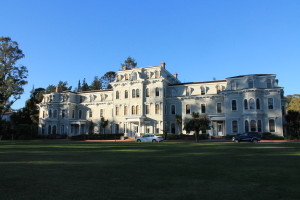
As a newcomer to the Oakland area, I had been looking for a new hiking trail and ways to explore Oakland since returning to campus for the semester. A trip to the Sequoia Bayview Trailhead was a beautiful balance of both goals.
On the drive up to the Oakland hills where Joaquin Miller Park is situated, the view of Oakland and the Bay burst from behind the trees that line the road. The morning air was cool as we stepped out of the car, and the trails already used by hikers, walkers, and mountain bikers.
The area my friend and I were traversing is part of a 500-acre plot of land that the City of Oakland maintains as a park combined with hiking trails. According to the government site, the land originally belonged to the poet Cinncinatus Hiner “Joaquin” Miller (1841-1913). In 1870 he visited Oakland, and sixteen years later, he returned to the area to live on a 70-acre swath of land on which he planted over 75,000 trees.
We started at the trailhead on the side of Sanborn Drive and dipped down into a wide trail that skirted the edge of a giant field, perfect for walking dogs, having a picnic, playing Frisbee, and other outdoor activities. As we were deciding which way to turn, a herd of mountain bikers pedaled through with their hooting and chattering fading into the distance. We turned down Sunset Trail, a well used, compacted main walkway that is lined with tall trees and carpeted with yellow leaves that led to other trails. The highway noise was soon eclipsed by birds calling, leaves rustling and feet walking.
The meandering trail narrowed into a dusty fork that led more paths. We decided to take Palos Colorados trail, a long, thin path that sloped down over a small ravine where a threadbare, quiet creek trickled through. We continued along the path, walking under a canopy of beautifully twisted bay trees curving above as their sharp scent gently infused the air. The sound of the bay leaves crunching on the ground set the beat to our walk.
Though much of the park remains untouched, a testament to the Bay Area’s natural beauty, it has not entirely escaped the urban sprawl. In more than a few places, the trail has been worn down to expose metal pipes with sharp edges– be aware of this if you plan on going to this area.
Several people and their dogs pass us as we clambered around. At the end of Palos Colorados trail, we came out into a residential neighborhood where my friend and I decided to turn around and go right back up so we can explore a different section of the park.

Back at the fork, we decided to take the Sinawik Trail. We hike up the steep but brief path to emerge higher up along Sanborn Drive and into the sun that had just emerged from clouds. This area was not dense forest, but instead a family area with grills, picnic tables and parking lots. The versatile aspects of this park continued to impress me as it is equipped with what a celebration or a family lunch would need.
At the end of our hike, we had walked about 3.4 miles. The area we wandered around had a pretty easy incline, but since we only experienced the Southern part of the park, there are possibilities to extend the hike, or find a more difficult path. In the carefully maintained environment of the park, it is easy to just mix and match, following the forks in no particular way. The versatility of the park, accommodating hiking trails, family gatherings, dog walking, outdoor field spaces, sculptures and more developed areas of the park for bigger festivals and events makes this park a wonderful place to explore on a calm Sunday.


